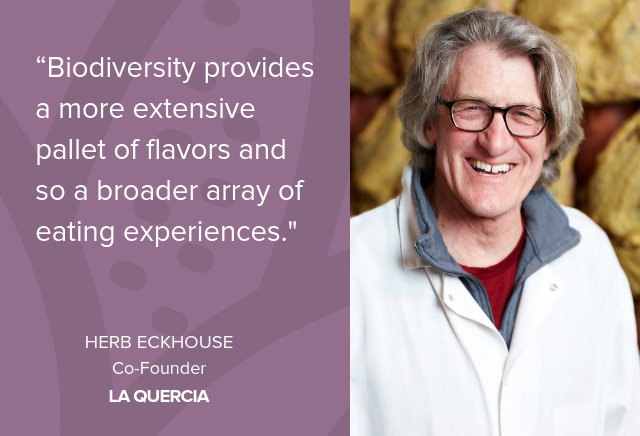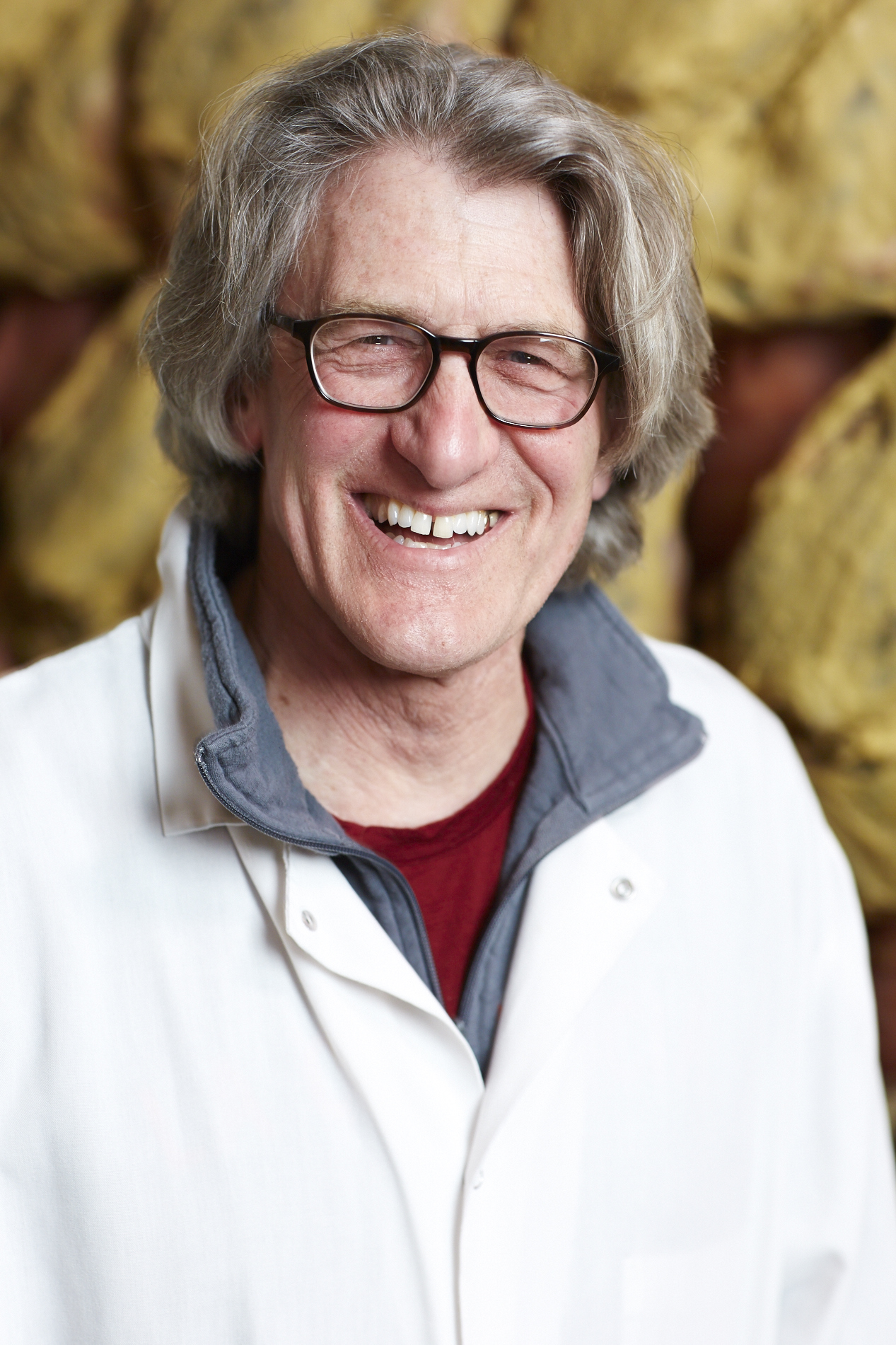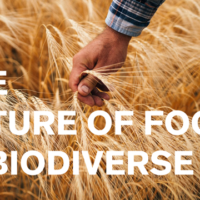
From January 7-31, Food+Tech Connect and The Future Market are hosting Biodiversity: The Intersection of Taste & Sustainability, an editorial series featuring interviews with over 45 leading food industry CEOs, executives, farmers, investors and researchers on the role of biodiversity in the food industry. See the full list of participants and read about why biodiversity in food is important here.
Below we speak with Herb Eckhouse, co-founder of La Quercia, maker of artisan salumi and dry cured meats from humanely raised heritage breed meat. Exckhouse explains that La Quercia’s commitment with biodiversity starts with flavor. Through working heritage animal breeders and local pork producers, La Quercia is able to delight its customers with unique flavors and eating experiences. Eckhouse argues that flavor is the gateway towards getting people to care about biodiversity. The company’s impact on the environment is also a priority for them. Based in Iowa, Eckhouse sees the devastating impact industrial monoculture and concentrated animal feedlots have had on the state’s soil, water and air.
____________________
Danielle Gould: Is biodiversity a priority for La Quercia? If so, how and why?
Herb Eckhouse: Yes. Our interest starts with the eating experience. Biodiversity provides a more extensive pallet of flavors and so a broader array of eating experiences, some of which are rare and delicious, and we want to offer those for the delight of people who buy our meats. From there, we move upstream to the impact on the world around us. Being based in Iowa, we see first hand the degradation of soil, water and air that comes from industrial monoculture and concentrated animal feeding operations. It’s easy to recognize this damage because it is right here around us and natural for us to want to help move the food system away from it.
DG: How does La Quercia define and think about biodiversity? How do you measure biodiversity, and when will we know when we’ve arrived at a “good” level of biodiversity?
HE: We have limited ability to impact broad-based biodiversity. We start from the eating experience and seek out special animal breeding — this is probably our best opportunity for direct influence and a way that we provide interest and special experiences to our customers. As long as we are able to effectively communicate the uniqueness of these foods and eaters are willing to reward us for doing this work, we can. From there, we’ve been working with our meat suppliers to influence their farmers’ practices. For some, we are a big customer and they want to work with us.
DG: What does an ideal biodiverse food system look like?
HE: I think that it is very hard to reconcile the structure of industrial level production with an “ideal biodiverse food system.” Industrial production favors uniformity, continuous availability and minimum costs. Biodiversity requires accounting for environmental costs and acceptance of variability. An ideal biodiverse food system will incorporate externalized environmental costs in pricing so that processors and consumers are required to pay those costs (many of which are currently borne by the rest of society, especially low-income and under-served communities). If the deadspot in the Gulf of Mexico starts shrinking and I don’t smell cow manure all the way across Nebraska, I think it will be an indicator that we are at a “good” level.
DG: What is La Quercia doing or planning to do to promote biodiversity?
HE: Directly, we are seeking out and supporting heritage breed production that we think offers superior deliciousness. Currently, we work with two European breeds known for superior cured meat quality: pasture raised purebred Iberico pork from Iberian Pastures, and Cinta pork coming from Curly Oak Cinta, a partnership between me and Ken Kehrli, an Iowa pork producer. Indirectly, we are working with one of our suppliers, Heritage Foods Farms, to influence their growers’ practices and include farming in their audited practices. We also buy a small amount of organic pork from a local producer.
These efforts are large for us, but small in the overall context. Our meat comes from an eligible supply that is 0.5 percent of the US total (non confinement and antibiotic free), and our special outdoor raised GAP 3 GMO free meat supply comes from a pool of probably at most 0.1 percent of the pork produced in the USA. By committing to buy and work with these special quality ingredients, we support the growth of this supply and promote practices that favor biodiversity.
DG: What is the business case for products that promote a more biodiverse food system?
HE: Biodiversity provides system strength and stability. We can see around us in Iowa that we have been using up what were once plentiful natural resources — clean air, clean water and deep, rich topsoil. Sooner or later this environmental degradation will make us unproductive or damage the customers who sustain us. In a positive way, there are consumers who look at how their food is made. For them, supporting biodiversity is a differentiator that may cause them to purchase our food and likely will increase their willingness to pay a premium for it.
DG: What investments need to be made to create a more biodiverse food system?
HE: Most importantly, consumers need to commit to knowing where their food comes from and to diligently purchasing food that incorporates biodiverse practices. Consumer education about the destruction inherent in industrialized monoculture is the first investment that needs to be made. Consumers need to learn that a biodiverse system may not have year-round availability of all products; they may need to accept some variation in quality and potentially higher prices. It starts at the end. If consumers learn why biodiversity is important and support it, it can happen.
DG: What are the greatest challenges and opportunities your La Quercia faces for creating a more biodiverse system? What are you doing to overcome or capture them?
HE: First, we need to make something really delicious from biodiverse ingredients. This is a perpetual challenge and opportunity; if we succeed, it makes it a lot easier to convince others that diversity is worth it. From there, establishing meaningful standards to define biodiversity and how to verify that you are supporting it is important and also not that easy. Finally, clear communication is a challenge. Unfortunately, the meanings of many words in the food world have eroded so that it is hard to find a reliable vocabulary. Sometimes we get fooled, sometimes consumers get fooled. That is one reason we have come to prefer audited systems like the GAP 5 step that offer verified compliance with clear, transparent, well defined standards; a third-party audited standard for sustainability would be very helpful. We continuously work with our suppliers to create this clear communication capability.
DG: Does your average customer care about biodiversity today?
HE: There is a small subset of consumers who are informed and care. Because of our efforts to source special meat, I suspect this is a more prevalent attitude in our customer group than among the average consumer. Why should they care? We have but one home planet, and we should love and respect it. How do you (or will you) get them to care? The best thing we can do to get them to care is to provide them with diverse and delightful eating experiences that showcase the benefits of diversity and stimulate then to ask, “where did this food come from?” and “why is it so tasty?”
DG: What are some of the most important things retailers, food manufacturers and other key parts of the food supply chain can do to support biodiversity?
HE: Gate keepers like restaurants and retailers play a critical role. Through their selections, they determine what is available to consumers. They communicate directly the special qualities of what they are selling to the next (and sometimes final) link in the food distribution chain. Just as we commit to buying meat from a very limited segment of the market, others in the food chain can too. This helps customers understand that this is important. Furthermore, as knowledgeable sources of expertise, they can be tremendously influential about what is important. We have to work on this together.
DG: Are there certain products you would like to see more of in the food industry — either in foodservice or CPG — that would help promote a more biodiverse agricultural system?
EH: In the meat world, the most important evolution necessary is full valuation and utilization of each animal. There are now large amounts (by weight) of each animal that do not become human food. If the full costs of meat get passed to consumers, perhaps this will change and we’ll start seeing people value feet and heads and bones highly enough that they can be distributed widely.
DG: What is your vision for what a more biodiverse food system looks like in 10-15 years?
EH: Right now, we take taxes and pay farmers to implement conservation practices. Some of these farmers are millionaires. This does not feel right to me. My vision is that farmers are compelled to embrace biodiversity and to pay directly for the costs of industrial monoculture (soil degradation, fertilizer and pesticide pollution) and that the market rewards those who embrace and foster biodiversity with higher prices.
Read all of the interviews here and learn more about Biodiversity at The Future Market.
______________________________
 Herb Eckhouse, Co-Fouder of La Quercia
Herb Eckhouse, Co-Fouder of La Quercia
Herb Eckhouse and wife, Kathy, began La Quercia with the goal of making uniquely delicious cured meats from humanely raised American pork. Their appreciation of fine cured meats was sparked by several years living in Parma, Italy, but it was the bounty of the Midwest that inspired them to start making prosciutto in their Des Moines, Iowa, basement a decade ago. Although the company now operates in a much larger facility in nearby Norwalk, Iowa, they still salt, work and trim each piece by hand in their aging rooms. La Quercia uses antibiotic free pork from family farms in the Midwest with an emphasis on humane husbandry, sustainable land practices, and heritage breeds.





